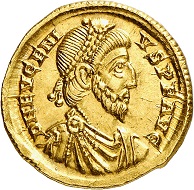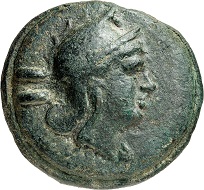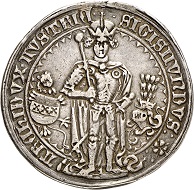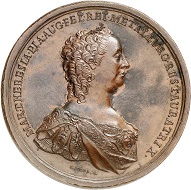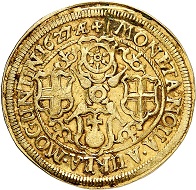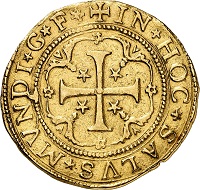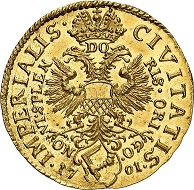18-03-2018 – 22-03-2018
Auctions 304-306
Künker’s spring auctions – the results
The spring auctions of Künker took place from March 19 to 23, 2018. Over the course of five days, 6,726 lots with a total estimate of 7.3 M euros were auctioned. The result was 11 M euros. Part of the reason for this increase was the high number of special collections. The gold coins from Mecklenburg and Lübeck for instance, which were estimated at 170,000 euros, reached a final price of 410,000 euros.
No. 1415: Eugenius, 392-394. Solidus, Treveri. Very rare. Extremely fine +. Estimate: 30,000 euros. Hammer price: 65,000 euros.
Auction 304: Coins from the ancient world
The auction week started with a highlight, the public sale of coins from the ancient world. The total result – a hammer price of 2.8 M euros for about 1,600 lots – speaks for itself. If you take a closer look, you will realize that the collectors of ancient coins tend to pay attention to four factors: grade, rarity, historical significance and provenance.
No. 126: Caulonia (Bruttium). Stater, 525-500. From John Pierpont Morgan collection. Extremely fine. Estimate: 10,000 euros. Hammer price: 16,000 euros.
A good example would be the incuse stater from Caulonia from the J. P. Morgan (1837-1913) collection. Estimated at 10,000 euros, it was sold for 16,000 euros. But it was not just the coins in the high price sector which saw such increments.
No. 137: Abakaenon (Sicily). Litra, 420-410. Geschichtsfreund collection. Very rare. Extremely fine. Estimate: 200 euros. Hammer price: 1,500 euros.
Let us take the example of a litra from Abacaenum. The Geschichtsfreund had bought it in 1988 at Sternberg. Its price climbed from 200 euros to 1,500 euros.
No. 437: Cyzicus (Mysia). Pharnabazus, Satrap 413-373. Tetradrachm, after 398. From the collection of a “Geschichtsfreund” and from the Hans von Aulock collection. Very rare. Very fine. Estimate: 25,000 euros. Hammer price: 50,000 euros.
Speaking of the Geschichtsfreund collection: It demonstrated collectors’ great interest in historically interesting coins from all price categories. Of course the 50,000 euros paid by the new owner of the tetradrachm from Cyzicus with the portrait of Pharnabazus, were impressive (estimate: 25,000 euros), but by direct comparison, an early siglos from the Achaemenids bought at Bankhaus Aufhäuser 12 in 1996, estimated at 100 euros, improved by a lot more: It reached a hammer price of 1,700 euros.
No. 548: Sardis (Lydia). Cyrus the Younger, + 401. Tetradrachm after Athenian model, around 407-404. On the cheek of the goddess Athena beardless portrait of Cyrus the Younger with tiara. From the collection of a “Geschichtsfreund”. Possibly unique. Very fine +. Estimate: 12,500 euros. Hammer price: 18,000 euros.
Here are three more results from the Geschichtsfreund collection: the owl with a tiny portrait of Cyrus the Younger sold for 18,000 euros (estimate: 12,500 euros), the owls with Aramaic letters for 8,500 and 7,000 euros respectively (estimate: both 1,000 euros.)
No. 37: Unknown mint (Etruria). AE-Sextans, 3rd cent. BC. Link Collection. Very rare. Very fine. Estimate: 200 euros. Hammer price: 2,200 euros.
The Link collection of Aes Grave was split between Greeks and Rome – after all the Etruscan and Italian cities are catalogued among the Greeks numismatically even if they are closely connected to Rome’s monetary history.
Some surprises were bound to arise. It is very rare that such a large amount and such a variety of material are put to auction. It was thus really difficult to find matching coins as comparandum from the previous years for the estimate. Just to name an example from the “Greek” world: A sextans from an unknown mint, which showed a wheel on the obverse and the reverse, had been estimated at 200 euros, only to be sold for 2,200 euros. Similar surprises also occurred in the Roman republic: A semunica from the years between 280 and 276 with a depiction of an oak and a thunderbolt went from 150 to 2,200 euros.
No. 835: Roman Republic. Dupondius, 265-242, Rome. From Eberhard Link collection. Very rare. Very fine. Estimate: 7,500 euros. Hammer price: 26,000 euros.
A very fine, very clearly cast Roman dupondius from the years between 265 and 242 became the most expensive coin of the Link collection. It had been estimated at 7,500 euros and reached a hammer price of 26,000 euros.
No. 1308: Saloninus as Caesar, 258-260. Aureus. Extremely rare. Almost extremely fine / Very fine. Estimate: 75,000 euros. Hammer price: 110,000 euro.
And with that we have arrived at the Roman coins. Experts could find a whole series of rare, exceptionally well preserved gold coins. We will just name a few top results. The most expensive coin was an aureus from Saloninus (75,000 / 110,000 euros), followed by a solidus from Eugenius (30,000 / 65,000 euros) and an aureus from Licinius I with a front portrait (25,000 / 52,500 euros).
No. 2133: Genoa / Italy. Scudo stretto, 1637, Genoa. Very rare. Very fine +. Estimate: 300 euros. Hammer price: 9,000 euros.
Auction 305: Coins and medals from the Middle Ages and the Early Modern Period
Collectors are attentive. And often they know more about the rarities of coins than coin dealers do. There are thus often surprises at auctions. Probably the most spectacular incident at the Künker spring auctions was the result of a Genoese scudo from the year 1637. Of course it was a rare year, which everyone knew, but no one could foresee that the coin, which had been estimated at 300 euros, would go for 9,000 euros in the end. Some other Italian fractions reached exorbitant prices due to their rarity. A 1/4 carlino of René of Anjou from Naples climbed up to 1,300 euros (estimate: 200 euros), a 1/4 lira from Francesco Giacinto di Savoia from the year 1638 climbed to 3,800 euros (estimate: 1,500 euros).
No. 2278: Dutch East Indies. Wilhelm I, 1815-1840. 1/2 gulden, 1834, Utrecht. PCGS MS 63. Rare. Extremely fine +. Estimate: 75 euros. Hammer price: 1.100 euros.
India has an enthusiastic community of collectors, too: A half gulden from 1834 for the Dutch East Indies in PCGS MS63 was estimated at 75 euros – the final price was 1,100 euros.
No. 2510: Holy Roman Empire. Sigismund Rich in Coins, 1446-1496. Guldiner 1486, Hall. Very rare. Solder mark. Very fine +. Estimate: 3,000 euros. Hammer price: 10,000 euros.
And here is a brief insight into the hammer prices for lots from the collections offered. The Habsburgs were represented with 400 lots in auction 305. There were almost exclusively coins in taler-size starting with Sigismund, Archduke of Austria and ending with Emperor Franz Joseph I. The results showed just how popular the Habsburg Dynasty currently is: The first guldiner with solder mark was an attractive but not perfect piece and it realised 10,000 euros (estimate: 3,000 euros), a triple schautaler from Ferdinand II, minted on occasion of his wedding in St. Veit in 1622 was sold for 5,500 euros (estimate: 1,250 euros) …
No. 2684: Holy Roman Empire. Leopold I, 1657-1705. Reichstaler, 1667, Nagybanya. Very rare. Nearly FDC. Estimate: 4,000 euros. Hammer price: 10,000 euros.
… and a precious reichstaler by Leopold I from 1667 from Nagybánya reached 10,000 euros (estimate: 4,000 euros).
No. 2780: Holy Roman Empire. Maria Theresa, 1740-1780. Bronze medal by G. Toda no date. Price medal for achievements in the art of coinage. Rare. Stained. Extremely fine. Estimate: 150 euros. Hammer price: 2.400 euros.
Of course there were a lot of surprises here, too. A slightly stained but otherwise extremely fine bronze prize medal from Maria Theresa for the achievements of minting, which had been estimated at 150 euros, went for 2,400 euros. After being estimated at only 500 euros, a 5 korona coin from Kremnica from the year 1900 in proof reached a final price of 4,800 euros – almost ten times the amount of its estimate.
No. 3527: Dortmund. Reichstaler 1564. From Schulman auction 225 (1955), No. 1598. Extremely rare. Very fine. Estimate: 50,000 euros. Hammer price: 65,000 euros.
The most outstanding coin from the Dortmund collection with almost 70 lots was a reichstaler from 1564 (50,000 / 65,000 euros). But a ducat from 1742 was also remarkable. The only privately owned coin changed owner with 22,000 euros (estimate: 7,500 euros).
No. 3795: Mainz. Georg Friedrich von Greiffenklau zu Vollraths, 1626-1629. Gold gulden 1627, Mainz. Extremely rare. Very fine. Estimate: 3,000 euros. Hammer price: 12,500 euros.
The Loos collection with coins and medals from Mainz entailed close to 150 lots. The gold gulden were particularly popular; so popular that the hammer price was one and a half times the estimate. Let us just name one outstanding piece – an extremely rare gold gulden from 1627, minted in Mainz that climbed from 3,000 euros to 12,500 euros.
No. 3933: Münster. Ferdinand von Bayern, 1612-1650. 5 ducats 1638, Münster. Golden off-strike made with dies of the reichstaler. Extremely rare. Nearly extremely fine. Estimate: 40,000 euros. Hammer price: 75,000 euros.
Let us end our report on auction 305 with the collection of Münster coins and medals, which brought in more than double of its estimate. Certainly there were many high results; we will limit ourselves to a 5 ducat coin from 1638 (40,000 / 75,000 euros), a double schautaler from 1638 (7,500 / 18,000 euros) and a 5 ducat coin from Christoph Bernhard von Galen (15,000 / 32,000 euros).
No. 5206: Genoa, Republic. 10 scudi 1624. Probably the only specimen on the market. Slightly clipped. Very fine. Estimate: 100,000 euros. Hammer price: 150,000 euros.
Auction 306: Gold coins / German coins from 1871 / Russian coins and medals
The two most expensive coins of the auction week changed their owner in auction 306. A 10-fold scudi from the Republic of Genoa from the year 1624 became the most expensive coin with 150,000 euros.
No. 7719: Russia. 10 rubel (1 imperial) 1896, St. Petersburg. Only 125 specimen minted. NGS MS 63. Extremely fine to FDC. Estimate: 100,000 euros. Hammer price: 120,000 euros.
A Russian coin, an imperial by Nicolas II from the year 1896, only 125 specimens of which were minted, (100,000 / 120,000 euros) made “second place”.
No. 6159: Lübeck. 2 ducats 1701. Very rare. Extremely fine to FDC. Estimate: 7,500 euros. Hammer price: 17,000 euros.
Both lots of gold coins from Lübeck and Mecklenburg were high flyers of the auction. More than 50 lots were comprised under “Lübeck”. The estimate was 63,000 euros, the hammer price around 120,000 euros. An extremely fine to proof double ducat from 1701 was the most outstanding piece (7,500 / 17,000 euros).
No. 6192: Mecklenburg. Friedrich Wilhelm, 1692-1713. Ducat 1703, Schwerin. Very rare. Extremely fine / Extremely fine to FDC. Estimate: 7,500 euros. Hammer price: 34,000 euros.
The coins from Mecklenburg reached even higher prices. The 50 lots with a total estimate of 110,000 euros went for almost triple the original price: 300,000 euros. High hammer prices like 34,000 euros for a ducat from 1703, minted in Schwerin (estimate: 7,500 euros) …
No. 6221: Mecklenburg. Adolf Friedrich IV, 1752-1794. 5 taler (pistole), 1754, Neustrelitz. Very rare. Very fine to extremely fine. Estimate: 7,500 euros. Hammer price: 42,000 euros.
… or even 42,000 euros for a pistole from 1754, minted Neustrelitz (estimate: 7,500 euros).
All results can be found online on the Künker website.
The upcoming auction will take place from June 18-22, 2018. You can order the catalogue at Künker, Nobbenburgerstr. 4a, 49 076 Osnabrück; Tel: 0541 / 96 20 20; Fax: 0541 / 96 20 222; or via e-mail.
What do you prefer: a written auction review or video clips? Compare for yourself by watching the film reviews of the these auction catalogues.




